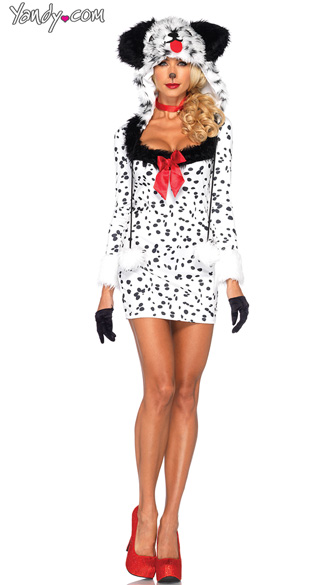
In the year 2014, it’s entirely unsurprising to see a human female dress up as a sexy 101 Dalmatians dog for Halloween and only mildly surprising to see an actual dalmatian dress up as a sexy human female, complete with fake cleavage.
When did Halloween become, as Lindsay Lohan so eloquently stated in 2004’s Mean Girls, “The one night of the year when you can dress like a slut and no other girls can say anything about it”? What is the history of the historically-themed sexy wooly mammoth or sexy George Washington costume?
As it turns out, the story goes all the way back to the very origins of Halloween.
Before you understand the sexy costume, you have to understand the non-sexy version. “There is a long tradition of costuming of sorts that goes back to Hallow Mass when people prayed for the dead,” explains Nicholas Rogers, a history professor at York University who has written about Halloween. “But they also prayed for fertile marriages, and the boy choristers in the churches dressed up as virgins. So there was a certain degree of cross dressing in the actual ceremony of All Hallow’s Eve.”
The precursors of today’s typical, non-religious Halloween costumes didn’t really emerge until Victorians in 19th-century America embraced the holiday, says author and Halloween expert Lesley Bannatyne, (“[People at the time] dressed in costumes at the drop of a hat!” she adds.) Many Victorians became familiar with the holiday after reading a popular Robert Burns poem called Halloween. “It included footnotes that basically told you how to throw a Halloween party in rural Scotland, and the Victorians just loved it,” Bannatyne says. “They were obsessed with ghosts at this time, and it was about rural Scotland which was just as exotic to them as Fiji or Borneo.”
Still, Victorian Americans tended to opt for costumes that were creepy — like bats and ghosts — rather than come-hither. “A gypsy or an Egyptian princess — again the exotic,” Bannatyne explains. “It wouldn’t have shown much skin, but it would have had the aura of being outside the box. It was seen as glamorous and kind of in the same vein as you see kids shopping for sexy costumes today — in some part of their minds they think it’s glamorous. ‘A night to do something that I wouldn’t ordinarily do and have people look at me.'”
The Halloween costume continued to gain popularity in the early 20th century, but the get-ups were still tame. The 20’s had paper costumes, which involved wearing crepe-paper hats or aprons over clothing to turn into a cauldron or cat. (Note: not a sexy cat.) After World War II, Halloween became a holiday that revolved around children and trick or treating. “Women would dress up as Minnie Mouse, but there wasn’t a sexy Minnie Mouse,” Bannatyne says — which Paris Hilton proved earlier this month is no longer the case:
It wasn’t until the 1970’s, when adults began celebrating Halloween again, this time after the sexual revolution, that the truly sexy costumes emerged.
“There started to be these outrageous gay Halloween parades in the Castro District, Greenwich Village and Key West,” Bannatyne says. “Combine second-wave feminism with outrageousness and a general atmosphere of freedom, and you have this perfect storm of more outrageous costumes.”
So there’s the deeper meaning of the sexy costume: Halloween is a reflection of what is happening in culture — what people are thinking and seeing, and which boundaries are most obviously begging to be pushed.
“There was a general attempt to capitalize on what seemed transgressive,” says Rogers, the historian. “And because it’s a night of transgression you can get away with it without it being seen as particularly offensive in any way.” (“Except for the Christian right,” he adds, “but they think everything is transgressive anyway.”)
In other words, when dressing as an Egyptian princess à la the late 1800’s was no longer daring, celebrants had to look elsewhere for a way to make Halloween special. And it’s not just a matter of sexiness. Bannatyne recalls that after a slew of incredibly violent horror movies came out in the 1980’s, people complained that Halloween revelers were wearing overly gory costumes. As movies and television shows began showing more nudity and higher hemlines, Halloween fashion began emulating that level of sexiness as well. Today, we live in an era of both irony and overexposure. Anything, ranging from a marshmallow peep to a Sesame Street character, can qualify as a sexy costume. Yandy co-founder Chad Horstman, whose company sells counterintuitive sexy costumes — for example, the sexy lobster — traces the emergence of unexpected risqué costumes to almost a decade ago.
“We started selling selling an image called Tina the Taxi Driver,” he says. “There is a market for these unusual and zany Halloween costumes.”
Especially if they show a lot of leg.
Adults will spend $1.4 billion on their own Halloween costumes this year, according to the National Retail Federation. The NRF doesn’t isolate for the sexy sector, but the fact that the sexy lobster even exists in the first place is evidence of how far we’ve come since the days of crepe-paper aprons. “It’s important to remember,” says Kathy Grannis, the organization’s senior director, “that retailers wouldn’t offer those options if they didn’t think there would be that kind of demand.”
Read TIME’s 1983 look at Halloween’s growing popularity among grown-ups, here in the archives: Halloween as an Adult Treat
More Must-Reads from TIME
- How Donald Trump Won
- The Best Inventions of 2024
- Why Sleep Is the Key to Living Longer
- Robert Zemeckis Just Wants to Move You
- How to Break 8 Toxic Communication Habits
- Nicola Coughlan Bet on Herself—And Won
- Why Vinegar Is So Good for You
- Meet TIME's Newest Class of Next Generation Leaders
Contact us at letters@time.com